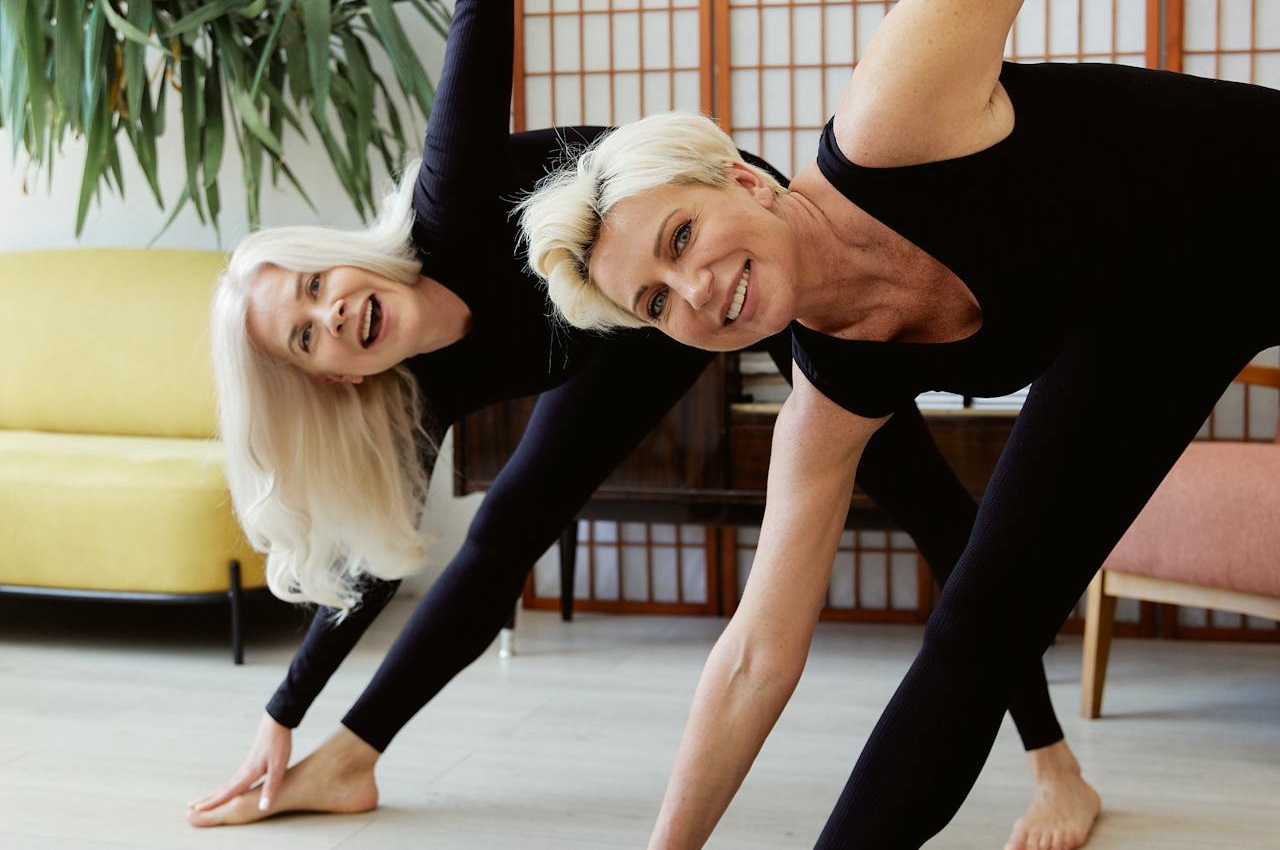Contents
Recently, one of my students asked me a question that really stuck with me:
“How do you stay fit for so long?”
At first, I smiled. It’s easy to assume that fitness is just about willpower or motivation, but the real answer goes much deeper. Staying fit isn’t about working harder—it’s about working smarter and more sustainably.
The truth is, staying fit over time isn’t just about working out more or eating perfectly. It’s about adapting your approach as life changes, staying connected to your why, and building a foundation rooted in consistency, recovery, and mindset.
What Does “Staying Fit Long-Term” Actually Mean?
When people say “fit,” they often think of six-pack abs or running a 10K. But long-term fitness is more holistic. It means:
- Maintaining a healthy body composition
- Retaining mobility, strength, and energy
- Supporting bone and joint health
- Managing weight sustainably
- Avoiding chronic pain and disease
You don’t need to chase extremes—you need to move with purpose and consistency.
The 7 Foundations of Staying Fit Long-Term
1. Consistency Beats Perfection
You don’t need to work out every day or eat clean 100% of the time. You just need to show up often enough that your habits start working for you. Even 3–4 days of purposeful movement per week can make a lasting difference.
Research published in JAMA shows that consistent moderate activity, such as walking or strength training 3–5 times per week, reduces mortality risk and preserves function.
Fitness is built in years, not days. The people who succeed long-term are those who don’t stop when life gets busy—they adjust and adapt.
2. Prioritize Strength Training
Strength training is crucial for preserving lean muscle, especially as we age. Starting around your 30s, you naturally begin to lose muscle (sarcopenia), which can affect your metabolism, mobility, and posture.
Women, in particular, benefit from resistance training to:
- Support bone density
- Manage hormones
- Preserves lean mass
- Boosts metabolism
- Prevent injuries and falls
Goal: 2–3 strength sessions per week, focusing on multi-joint movements like squats, deadlifts, rows, and presses.
3. Include Cardiovascular Movement
Heart health matters—but so does brain health, mood regulation, and endurance. Aerobic training supports all of these.
- 150 minutes of moderate activity (brisk walking, cycling)
- or 75 minutes of vigorous activity (running, HIIT) per week
Even short daily walks help with stress, blood pressure, and blood sugar.
4. Adjust Your Workouts With Age
Fitness isn’t static. The same routine that worked in your 20s may need adjustments in your 40s, 50s, or 60s.
- Include mobility and balance training
- Allow more time for warm-up and recovery
- Use periodization (alternating high/low intensity phases)
- Schedule deload weeks every 6–8 weeks to avoid burnout
Staying fit long-term is not about doing more—it’s about doing enough, sustainably.
5. Fuel With Real, Supportive Nutrition
You don’t need fad diets. Focus on nutrition that supports your goals and energy:
- 20–30g protein per meal
- Colorful veggies and fiber
- Anti-inflammatory fats (avocados, nuts, olive oil)
- Hydration and mindful eating
And yes—enjoy your treats in moderation. Balance keeps things livable.
6. Recovery Is Essential, Not Optional
Want to stay fit for life? You must respect recovery.
- Sleep 7–9 hours
- Manage stress through breathing, yoga, or journaling
- Take full rest days and active recovery walks
- Use foam rolling or mobility drills to maintain joint health
7. Keep a Strong “Why” and Community
Fitness isn’t just a physical act—it’s a mindset. The people who stick with it:
- Connect it to a deeper purpose (health, family, longevity)
- Don’t make excuses—they make adjustments
- Surround themselves with support (coaches, friends, communities)
Lessons From My Own Fitness Journey
Here’s how I’ve stayed fit for over 15 years—without burning out:
- I don’t skip two days in a row. One? Sure. But not two.
- I treat workouts like appointments—non-negotiable but flexible.
- I train for strength and function, not just looks.
- I rest hard, especially when I’m pushing myself.
- I update my program every few months to stay engaged.
And above all, I remind myself: movement is a gift—not a punishment.
Mistakes to Avoid on Your Fitness Journey
If you’re just starting out (or restarting), beware of these common traps:
| Mistake | Why It Hurts Long-Term |
|---|---|
| All-or-nothing mindset | Leads to burnout or quitting |
| Ignoring strength training | Misses the foundation of fitness |
| No recovery strategy | Increases injury and fatigue |
| Sticking to the same routine forever | Results in plateaus and boredom |
| Focusing only on aesthetics | Misses the big picture of health |
It’s Not About Doing More—It’s About Doing What Lasts
Staying fit “so long” doesn’t mean being perfect. It means finding what works for you, consistently, over time.
It means:
- Choosing movement daily, even in small ways
- Prioritizing health over hustle
- Adjusting goals as life evolves
- Building a lifestyle that supports energy, strength, and joy
Anyone can get fit for 30 days. Lifelong fitness? That takes vision, strategy, and compassion for yourself.
Conclusion: The Real Secret to Staying Fit Long-Term
There’s no magic trick to staying fit for life. It comes down to this:
- Move your body regularly.
- Lift, walk, and rest.
- Eat mostly whole foods.
- Sleep, manage stress, and stay hydrated.
- Adapt to your season of life.
- Most importantly—keep showing up.
Let fitness grow with you, not work against you.
Citations and References
- American College of Sports Medicine. (2021). ACSM’s Guidelines for Exercise Testing and Prescription (11th ed.).
- Schoenfeld, B. J. (2010). The mechanisms of muscle hypertrophy and their application to resistance training. J Strength Cond Res, 24(10), 2857–2872.
- WHO. (2020). Physical Activity. https://www.who.int/news-room/fact-sheets/detail/physical-activity
- Garber, C. E., et al. (2011). Quantity and quality of exercise. Med Sci Sports Exerc, 43(7), 1334–1359.
- Harvard Health Publishing. (2022). Why strength training is essential for your health.



